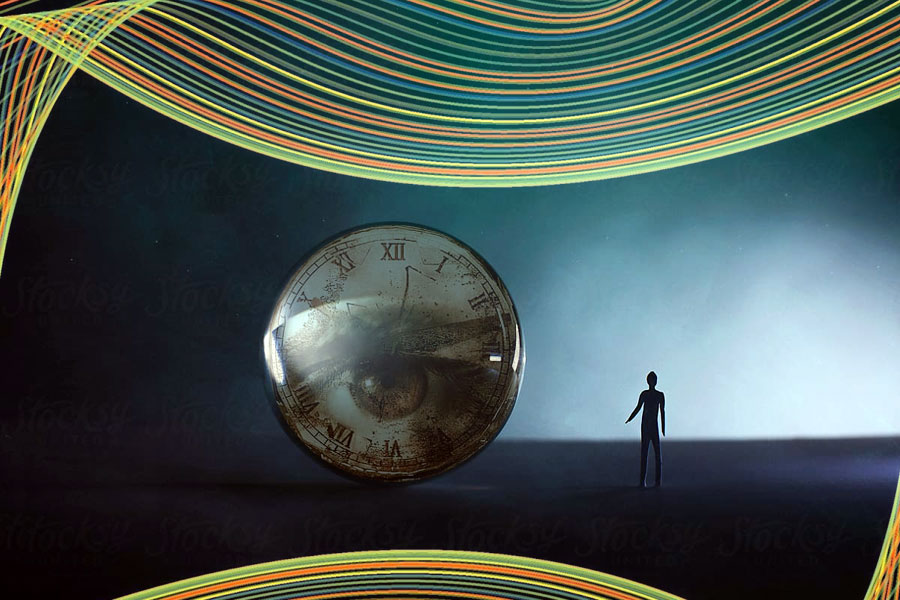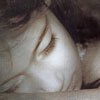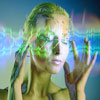Precognition ~ Part I
 by Maurice Maeterlinck
by Maurice Maeterlinck
Premonition or precognition leads us to mysterious regions, where stands, half merging from an intolerable darkness, the gravest problem that can thrill mankind, the knowledge of the future. The latest, the best and the most complete study devoted to it is, I believe, that recently published by M. Ernest Bozzano, under the title Des Phenomenes Premonitoires. Availing himself of excellent earlier work, notably that of Mrs. Sidgwick and Myers and adding the result of his own researches, the author collects some thousand cases of precognition, of which he discusses one hundred and sixty, leaving the great majority of the others on one side. Not because they are negligible, but because he does not wish to exceed too flagrantly the normal limits of a monograph.
He begins by carefully eliminating all the episodes which, though apparently premonitory, may be explained by self-suggestion (as in the case, for instance, where some one smitten with a disease still latent seems to foresee this disease and the death which will be its conclusion), by telepathy (when a sensitive is aware beforehand of the arrival of a person or a letter), or lastly by clairvoyance (when a man dreams of a spot where he will find something which he has mislaid, or an uncommon plant, or an insect sought for in vain, or of the unknown place which he will visit at some later date).
In all these cases, we have not, properly speaking, to do with a pure future, but rather with a present that is not yet known. Thus reduced and stripped of all foreign influences and intrusions the number of instances in which there is a really clear and incontestable perception of a fragment of the future remains large enough, contrary to what is generally believed, to make it impossible for us to speak of extraordinary accidents or wonderful coincidences. There must be a limit to everything, even to distrust, even to the most extensive incredulity, otherwise all historical research and a good deal of scientific research would become decidedly impracticable. And this remark applies as much to the nature of the incidents related as to the actual authenticity of the narratives. We can contest or suspect any story whatever, any written proof, any evidence; but thenceforward we must abandon all certainty or knowledge that is not acquired by means of mathematical operations or laboratory experiments, that is to say, three-fourths of the human phenomena which interest us most. Observe that the records collected by the investigators of the S. P. R., like those discussed by M. Bozzano, are all told as first hand and that those stories of which the narrators were not the protagonists or the direct witnesses have been ruthlessly rejected. Furthermore, some of these narratives are necessarily of the nature of medical observations; as for the others, if we attentively examine the character of those who have related them and the circumstances which corroborate them, we shall agree that it is more just and more reasonable to believe in them than to look upon every man who has an extraordinary experience as being a priori, a liar, the victim of an hallucination, or a wag.
There could be no question of giving here even a brief analysis of the most striking cases. It would require a hundred pages and would alter the whole nature of this essay, which, to keep within its proper dimensions, most take it for granted that most of the materials which it examines are familiar. I therefore refer the reader who may wish to form an opinion for himself to the easily-accessible sources which I have mentioned above. It will suffice, to give an accurate idea of the gravity of the problem to anyone who has not time or opportunity to consult the original documents if I sum up in a few words some of these pioneer adventures, selected among those which seem least open to dispute; for it goes without saying that all have not the same value, otherwise the question would be settled. There are some which, while exceedingly striking at first sight and offering every guarantee that could be desired to authenticity, nevertheless do not imply a real knowledge of the future and can be interpreted in another manner. I give one, to serve as an instance; it is reported by Dr. Alphonse Teste in his Manuel Pratique Du Magnetisme Animal.
On the 8th of May, Dr. Teste hypnotizes Mme. Hortense—in the presence of her husband. She is no sooner asleep than she announces that she has been pregnant for a fortnight, that she will not go her full time, that “she will take fright at something,” that she will have a fall and that the result will be a miscarriage. She adds that, on the 12th of May, after having had a fright, she will have a fainting-fit which will last for eight minutes; and she then describes, hour by hour, the course of her malady, which will end in three days’ loss of reason, from which she will recover.
On awaking, she retains no recollection of anything that has passed; it is kept from her; and Dr. Teste communicates his notes to Dr. Amidee Latour. On the 12th of May, he calls on M. and Mme.—, finds them at table and puts Mme.— to sleep again, whereupon she repeats word for word what she told him four days before. They wake her up. The dangerous hour is drawing near. They take every imaginable precaution and even close the shutters. Mme.—, made uneasy by these extraordinary measures which she is quite unable to understand, asks what they are going to do to her. Half past three o’clock strikes. Mme.— rises from the sofa on which they have made her sit and wants to leave the room. The doctor and her husband try to prevent her.
“But what is the matter with you?” she asks. “I simply must go out.”
“No, madame, you shall not: I speak in the interest of your health.”
“Well, then, doctor,” she replies, with a smile, “if it is in the interest of my health, that is all the more reason why you should let me go out.”
The excuse is a plausible one and even irresistible; but the husband, wishing to carry the struggle against destiny to the last, declares that he will accompany his wife. The doctor remains alone, feeling somewhat anxious, in spite of the rather farcical turn which the incident has taken. Suddenly, a piercing shriek is heard and the noise of a body falling. He runs out and finds Mme.— wild with fright and apparently dying in her husband’s arms. At the moment when, leaving him for an instant, she opened the door of the place where she was going, a rat, the first seen there for twenty years, rushed at her and gave her so great a start that she fell flat on her back. And all the rest of the prediction was fulfilled to the letter, hour by hour and detail by detail.
To make it quite clear in what spirit I am undertaking this study and to remove at the beginning any suspicion of blind or systematic credulity, I am anxious, before going any further, to say that I fully realize that cases of this kind by no means carry conviction. It is quite possible that everything happened in the subconscious imagination of the subject and that she herself created, by self-suggestion, her illness, her fright, her fall and her miscarriage and adapted herself to most of the circumstances which she had foretold in her secondary state. The appearance of the rat at the fatal moment is the only thing that would suggest a precise and disquieting vision of an inevitable future event. Unfortunately, we are not told that the rat was perceived by other witnesses than the patient, so that there is nothing to prove that it also was not imaginary. I have therefore quoted this inadequate instance only because it represents fairly well the general aspect and the indecisive value of many similar cases and enables us to note once and for all the objections which can be raised and the precautions which we should take before entering these suspicious and obscure regions.
We now come to an infinitely more significant and less questionable case related by Dr. Joseph Maxwell, the learned and very scrupulous author of Les Phenomenes Psychiques, a work which has been translated into English under the title of Metapsychical Phenomena. It concerns a vision which was described to him eight days before the event and which he told to many people before it was accomplished. A sensitive perceived in a crystal the following scene: a large steamer, flying a flag of three horizontal bars, black, white and red, and bearing the name Leutschland, was sailing in mid-ocean. The boat was suddenly enveloped in smoke; a great number of sailors, passengers and men in uniform rushed to the upper deck; and the boat went down.
Eight days afterwards, the newspapers announced the accident to the Deutschland, whose boiler had burst, obliging the steamboat to stand to.
The evidence of a man like Dr. Maxwell, especially when we have to do with a so-to speak personal incident, possesses an importance on which it is needless to insist. We have here, therefore, several days beforehand, the very clear prevision of an event which, moreover, in no way concerns the percipient: a curious detail, but one which is not uncommon in these cases. The mistake in reading Leutschland for Deutschland, which would have been quite natural in real life, adds a note of probability and authenticity to the phenomenon. As for the final act, the foundering of the vessel in the place of a simple heaving to, we must see in this, as Dr. J. W. Pickering and W. A. Sadgrove suggest, “the subconscious dramatization of a subliminal inference of the percipient.” Such dramatization, moreover, are instinctive and almost general in this class of visions.
If this were an isolated case, it would certainly not be right to attach decisive importance to it; “but,” Dr. Maxwell observes, “the same sensitive has given me other curious instances; and these cases, compared with others which I myself have observed or with those of which I have received first-hand accounts, render the hypothesis of coincidence very improbable, though they do not absolutely exclude it.”
Another and perhaps more convincing case, more strictly investigated and established, a case which clearly does not admit of explanation, by the theory of coincidence, worthy of all respect though this theory be, is that related by M. Theodore Flournoy, science professor at the university of Geneva, in his remarkable work, Esprits et Mediums. Professor Flournoy is known to be one of the most learned and most critical exponents of the new science of metaphysics. He even carries his fondness for natural explanations and his repugnance to admit the intervention of superhuman powers to a point where it is often difficult to follow him. I will give the narrative as briefly as possible. It will be found in full on pp. 348 to 362 of his masterly book.
In August, 1883, a certain Mme. Buscarlet, whom he knew personally, returned to Geneva after spending three years with the Moratief family at Kazan as governess to two girls. She continued to correspond with the family and also with a Mme. Nitchinof, who kept a school at Kazan to which Mlles. Moratief, Mme. Buscarlet’s former pupils, went after her departure.
On the night of the 9th of December (O. S.) of the same year, Mme. Buscarlet had a dream which she described the following morning in a letter to Mme. Moratief, dated 10 December. She wrote, to quote her own words:
“You and I were on a country-road when a carriage passed in front of us and a voice from inside called to us. When we came up to the carriage, we saw Mlle. Olga Popoi lying across it, clothed in white, wearing a bonnet trimmed with yellow ribbons. She said to you:
“‘I called you to tell you that Mme. Nitchinof will leave the school on the 17th.’
“The carriage then drove on.”
A week later and three days before the letter reached Kazan, the event foreseen in the dream was fulfilled in a tragic fashion. Mme. Nitchinof died on the 16th of an infectious disease; and on the 17th her body was carried out of the school for fear of infection.
It is well to add that both Mme. Buscarlet’s letter and the replies which came from Russia were communicated to Professor Flournoy and bear the postmark dates.
Such premonitory dreams are frequent; but it does not often happen that circumstances and especially the existence of a document dated previous to their fulfillment give them such incontestable authenticity.
We may remark in passing the odd character of this premonition, which however is fully in accordance with the habits of our unknown guest. The date is fixed precisely; but only a veiled and mysterious allusion (the woman lying across the carriage and cloaked in white) is made to the essential part of the prediction, the illness and death.
Was there a coincidence, a vision of the future pure and simple, or a vision of the future suggested by telepathic influence? The theory of coincidence can be defended, if need be, here as everywhere else, but would be very extraordinary in this case. As for telepathic influence, we should have to suppose that, on the 9th of December, a week before her death, Mme. Nitchinof had, in her subconsciousness, a presentiment of her end and that she transmitted this presentiment across some thousands of miles, from Kazan to Geneva, to a person with whom she had never been intimate. It is very complex, but possible, for telepathy often has these disconcerting ways. If this were so, the case which would be one of latent illness or even of self-suggestion; and the pre-existence of the future, without being entirely disproved, would be less clearly established.
Let us pass to other examples. I quote from an excellent article of the importance of precognitions, by Messrs. Pickering and Sadgrove, which appeared in the Annales des Sciences Psychiques for 1 February 1908, the summary of an experiment by Mrs. A. W. Verrall told in full detail in Vol. XX of the Proceedings. Mrs. Verrall is a celebrated “automatist”; and her “cross-correspondence” occupy a whole volume of the Proceedings. Her good faith, her sincerity, her fairness and her scientific precision are above suspicion; and she is one of the most active and respected members of the Society for Psychical Research.
She wrote through automatic writing:
“Do not hurry date this hoc est quod volui—tandem. {greek here} A. W. V. {greek here}. calx pedibus inhaerens difficultatem superavit. magnopere adiuvas persectando semper. Nomen inscribere iam possum—sic, en tibi!”
After the writing comes a humorous drawing representing a bird walking.
That same night, as there were said to be “uncanny happenings” in some rooms near the London Law Courts, the watchers arranged to sit through the night in the empty rooms. Precautions were taken to prevent intrusion and powdered chalk was spread on the floor of the two smaller rooms, “to trace anybody or anything that might come or go.” Mrs. Verrall knew nothing of the matter. The phenomena began at 12:43 A.M. and ended at 2:09 A.M. The watchers noticed marks on the powdered chalk. On examination it was seen that the marks were “clearly defined bird’s footprints in the middle of the floor, three in the left-hand room and five in the right-hand room.” The marks were identical and exactly 2 3/4 inches in width; they might be compared to the footprints of a bird about the size of a turkey. The footprints were observed at 2:30 A. M.; the unexplained phenomena had begun at 12:43 that same morning. The words about “chalk sticking to the feet” are a singularly appropriate comment on the events; but the remarkable point is that Mrs. Verrall wrote what we have said ONE HOUR AND THIRTY-THREE MINUTES BEFORE THE EVENTS TOOK PLACE.
The persons who watched in the two rooms were questioned by Mr. J. G. Piddington, a member of the council of the S. P. R., and declared that they had not any expectation of what they discovered.
I need hardly add that Mrs. Verrall had never heard anything about the happenings in the haunted house and that the watchers were completely ignorant of Mrs. Verrall’s existence.
Here then is a wry curious prediction of an event, insignificant in itself, which is to happen, in a house unknown to the one who foretells it, to people whom she does not know either. The spiritualists, who score in this case, not without some reason, will have it that a spirit, in order to prove its existence and its intelligence, organized this little scene in which the future, the present and the past are all mixed up together. Are they right? Or is Mrs. Verrall’s subconsciousness roaming like this, at random, in the future? It is certain that the problem has seldom appeared under a more baffling aspect.
We will now take another premonitory dream, strictly controlled by the committee of the S. P. R. Early in September, 1893, Annette, wife of Walter Jones, tobacconist, of Old Gravel Lane, East London, had her little boy ill. One night she dreamt that she saw a cart drive up and stop near where she was. It contained three coffins, “two white and one blue. One white coffin was bigger than the other; and the blue was the biggest of the three.” The driver took out the bigger white coffin and left it at the mother’s feet, driving off with the others. Mrs. Jones told her dream to her husband and to a neighbor, laying particular stress on the curious circumstance that one of the coffins was blue.
On the 10th of September, a friend of Mr. and Mrs. Jones was confined of a boy, who died on the 29th of the same month. Their own little boy died on the following Monday, the 2nd of October, being then sixteen months old. It was decided to bury the two children on the same day. On the morning of the day chosen, the parish priest informed Mr. and Mrs. Jones that another child had died in the neighborhood and that its body would be brought into church along with the two others. Mrs. Jones remarked to her husband:
“If the coffin is blue, then my dream will come true. For the two other coffins were white.”
The third coffin was brought; it was blue. It remains to be observed that the dimensions of the coffins corresponded exactly with the dream premonitions, the smallest being that of the child who died first, the next that of the little Jones boy, who was sixteen months old, and the largest, the blue one, that of a boy six years of age.
Let us take, more or less at random, another case from the inexhaustible Proceedings. The report is written by Mr. Alfred Cooper and attested by the Duchess of Hamilton, the Duke of Manchester and another gentleman to whom the duchess related the incident before the fulfillment of the prophetic vision:
“A fortnight before the death of the late Earl of L.—,” says Mr. Cooper, “in 1882, I called upon the Duke of Hamilton, in Hill Street, to see him professionally. After I had finished seeing him, we went into the drawing-room where the duchess was, and the duke said to me:
“‘Oh, Cooper, how is the earl?’
“The duchess said, ‘What earl?’ and, on my answering, ‘Lord L—,’ she replied:
“‘That is very odd. I have had a most extraordinary vision. I went to bed, but, after being in bed a short time, I was not exactly asleep, but thought I saw a scene as if from a play before me. The actors in it were Lord L—, in a chair, as if in a fit, with a man standing near him with a red beard. He was by the side of a bath, over which bath a red lamp was distinctly shown.’
“I then said:
“‘I am attending Lord L— at present; there is very little the matter with him; he is not going to die; he will be all right very soon.’
“Well, he got better for a week and was nearly well, but, at the end of six or seven days after this, I was called to see him suddenly. He had inflammation of both lungs.
“I called in Sir William Jenner, but in six days he was a dead man. There were two male nurses attending on him; one had been taken ill. But, when I saw the other, the dream of the duchess was exactly represented. He was standing near a bath over the earl and, strange to say, his beard was red. There was the bath with the red lamp over it; and this brought the story to my mind.
“The vision seen by the duchess was told two weeks before the death of Lord L—. It is a most remarkable thing.”
But it is impossible to find space for the many instances related. As I have said, there are hundreds of them, making their tracks in every direction across the plains of the future. Those which I have quoted give a sufficient idea of the predominating tone and the general aspect of this sort of story. It is nevertheless right to add that many of them are not at all tragic and that premonition opens its mysterious and capricious vistas of the future in connection with the most diverse and insignificant events. It cares but little for the human value of the occurrence and puts the vision of a number in a lottery in the same plane as the most dramatic death. The roads by which it reaches us are also unexpected and varied. Often, as in the examples quoted, it comes to us in a dream. Sometimes, it is an auditory or visual hallucination which seizes upon us while awake; sometimes, an indefinable but clear and irresistible presentiment, a shapeless but powerful obsession, an absurd but imperative certainty which rises from the depths of our inner darkness, where perhaps lies hidden the final answer to every riddle.
One might illustrate each of these manifestations with numerous examples. I will mention only a few, selected not among the most striking or the most attractive, but among those which have been most strictly tested and investigated. A young peasant from the neighborhood of Ghent, two months before the drawing for the conscription, announces to all and sundry that he will draw number 90 from the urn. On entering the presence of the district-commissioner in charge, he asks if number 90 is still in. The answer is yes.
“Well then, I shall have it!”
And, to the general amazement, he does draw number 90.
Questioned as to the manner in which he acquired this strange certainty, he declared that, two months ago, just after he had gone to bed, he saw a huge, indescribable form appear in a corner of his room, with the number 90 standing out plainly in the middle, in figures the size of a man’s hand. He sat up in bed and shut and opened his eyes to persuade himself that he was not dreaming. The apparition remained in the same place, distinctly and undeniably.
Professor Georges Hulin, of the university of Ghent, and M. Jules van Dooren, the district commissioner, who reported the incident, mentioned three other similar and equally striking cases witnessed by M. van Dooren during his term of office. I am the less inclined to doubt their declaration inasmuch as I am personally acquainted with them and know that their statements, as regards the objective reality of the facts, are so to speak equivalent to a legal deposition. M. Bozzano mentions some previsions which are quite as remarkable in connection with the gaming-tables at Monte Carlo.
I repeat, I am aware that, in the case of these occurrences and those which resemble them, it is possible once again to invoke the theory of coincidence. It will be contended that there are probably a thousand predictions of this kind which are never talked about, because they were not fulfilled, whereas, if one of them is accomplished, which is bound by the law of probabilities to happen some day or other, the astonishment is general and free rein is given to the imagination. This is true; nevertheless, it is well to inquire whether these predictions are as frequent as is loosely stated. In the matter of those which concern the conscription-drawings, for instance, I have had the opportunity of interrogating more than we constant witness of these little dramas of fate; and all admitted that, on the whole, they are much clearer than one would believe. Next, we must not forget that there can be no question here of scientific proofs. We are in the midst of a slippery and nebulous region, where we would not dare to risk a step if we were not allowing ourselves to be guided by our feelings rather than by certainties which we are not forbidden to hope for, but which are not yet in sight.
Excerpt from The Unknown Guest
See Part II here.
Posted in ESP, Other Topicswith comments disabled.





